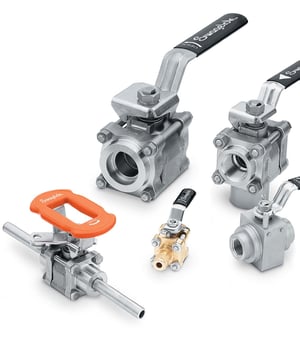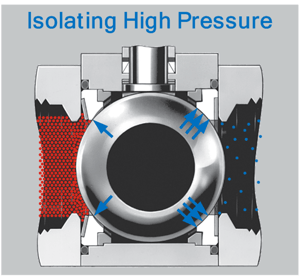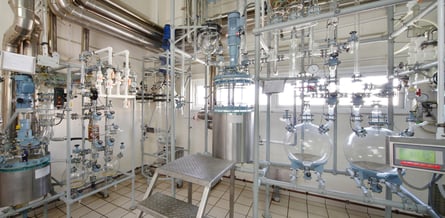Share this
Sizing Up A Valve: Which One Works Best For Your Application?
by Jeff Hopkins on 10/16/19 9:00 AM
"Some valves are designed to provide good control of flow or direction, or guard against over-pressure"
- From Choosing the Right Swagelok Valve for the Job: Part 2

You need to pay attention to more than just the size of the end connection
Even if a valve's end connections match up to the rest of your fluid system, you still might not have the right size valve for the job. When we talk about the size of a valve, we really mean the amount of flow that the valve can provide.
Basic flow calculations are simple, as illustrated by the common orifice flow meter (Fig. 1). We need to know only the size and shape of the orifice, the diameter of the pipe, and the fluid density. With that information, we can calculate the flow rate for any value of pressure drop across the orifice (the difference between inlet and outlet pressures).
 For a valve, we also need to know all the valve passage dimensions and all the changes in size and direction of flow through the valve. Fortunately, you don't have to make complex calculations. The valve manufacturer has done that for you already, combining the effects of all the flow restrictions into a single number called a valve flow coefficient.
For a valve, we also need to know all the valve passage dimensions and all the changes in size and direction of flow through the valve. Fortunately, you don't have to make complex calculations. The valve manufacturer has done that for you already, combining the effects of all the flow restrictions into a single number called a valve flow coefficient.
Liquid and gas flow
 Because liquids are incompressible fluids, their flow rate depends only on the difference between the inlet and outlet pressures, called the pressure drop. The flow is the same whether the system pressure is low or high, so long as the difference between the inlet and outlet pressures is the same.
Because liquids are incompressible fluids, their flow rate depends only on the difference between the inlet and outlet pressures, called the pressure drop. The flow is the same whether the system pressure is low or high, so long as the difference between the inlet and outlet pressures is the same.
Gas flow calculations are slightly more complex. Gases are compressible fluids, so their density changes with pressure. In addition, there are two conditions that must be considered—low pressure drop flow and high pressure drop flow.
In low pressure drop flow—when the outlet pressure is greater than half of the inlet pressure—the outlet pressure restricts flow through the orifice: as outlet pressure decreases, flow increases, and so does the velocity of the gas leaving the orifice.
When the outlet pressure decreases to half of the inlet pressure, the gas leaves the orifice at the velocity of sound. The gas cannot exceed the velocity of sound, so this becomes the maximum flow rate. The maximum flow rate is also known as choked flow or critical flow.
No matter how much you decrease outlet pressure after that, you can't increase flow, even if the outlet pressure is reduced to zero.
Consequently, high pressure drop flow only depends on inlet pressure and not outlet pressure.
All the details
We have a special technical bulletin with all the equations and graphs you need for valve sizing. They include correction factors for the specific gravity of various fluids, and for the effects of temperature. It's available as a free download, along with a tutorial on valve selection and a valve-selection worksheet. Get all three PDFs by clicking here and filling out the form.
As always, the associates at Swagelok Northern California are glad to talk with you about what you are trying to accomplish, so we can help you make the right product selections.
Just ask
Swagelok Northern California has a great deal of exposure to all aspects of fluid system design and engineering. Whether you have a simple question or a complex challenge, we're glad to hear from you.
More like this:
Share this
- Archive (465)
- Assembly Services (207)
- About (100)
- Seal Support Systems (96)
- Best Practices (88)
- Training Services (74)
- Fittings (51)
- Semiconductor Applications (49)
- Hoses and Flexible Tubing (47)
- Regulators (44)
- Tubing (42)
- Grab Sampling Systems (32)
- Sampling Systems (32)
- Gas Systems (30)
- Services (30)
- Downloads (29)
- Valves (24)
- Application Support (18)
- Orbital Welding (17)
- Case Studies (13)
- Steam Systems (13)
- Frequently Asked Questions (12)
- Tools (12)
- Measurement Devices (7)
- Subsystems (6)
- Thermal Management (6)
- September 2023 (1)
- August 2023 (2)
- June 2023 (1)
- March 2023 (3)
- February 2023 (3)
- January 2023 (4)
- December 2022 (4)
- November 2022 (4)
- October 2022 (4)
- September 2022 (1)
- August 2022 (3)
- July 2022 (2)
- June 2022 (4)
- May 2022 (1)
- April 2022 (2)
- March 2022 (1)
- February 2022 (2)
- January 2022 (3)
- December 2021 (1)
- November 2021 (6)
- October 2021 (6)
- September 2021 (8)
- August 2021 (4)
- July 2021 (3)
- June 2021 (6)
- May 2021 (6)
- April 2021 (7)
- March 2021 (5)
- February 2021 (4)
- January 2021 (6)
- December 2020 (5)
- November 2020 (6)
- October 2020 (6)
- September 2020 (8)
- August 2020 (7)
- July 2020 (8)
- June 2020 (8)
- May 2020 (6)
- April 2020 (9)
- March 2020 (7)
- February 2020 (10)
- January 2020 (21)
- December 2019 (23)
- November 2019 (21)
- October 2019 (22)
- September 2019 (21)
- August 2019 (22)
- July 2019 (23)
- June 2019 (20)
- May 2019 (23)
- April 2019 (22)
- March 2019 (21)
- February 2019 (20)
- January 2019 (21)
- December 2018 (14)
- November 2018 (19)
- October 2018 (23)
- September 2018 (17)
- August 2018 (29)
- July 2018 (11)
- June 2018 (6)
- May 2018 (5)
- April 2018 (4)
- March 2018 (5)
- February 2018 (3)
- January 2018 (3)
- December 2017 (2)
- November 2017 (4)
- October 2017 (3)
- September 2017 (2)
- August 2017 (6)
- July 2017 (4)
- June 2017 (4)
- May 2017 (4)
- April 2017 (3)
- March 2017 (4)
- February 2017 (3)
- January 2017 (3)
- December 2016 (3)
- November 2016 (3)
- October 2016 (3)
- September 2016 (5)
- August 2016 (5)
- July 2016 (4)
- June 2016 (5)
- May 2016 (3)
- April 2016 (4)
- March 2016 (5)
- February 2016 (11)
- January 2016 (1)
- December 2015 (3)
- November 2015 (4)
- October 2015 (3)
- September 2015 (4)
- August 2015 (4)
- July 2015 (8)
- June 2015 (5)
- May 2015 (3)
- April 2015 (4)
- March 2015 (4)
- February 2015 (3)
- January 2015 (4)
- December 2014 (2)
- November 2014 (3)
- October 2014 (4)
- September 2014 (4)
- August 2014 (4)
- July 2014 (5)
- June 2014 (4)
- May 2014 (4)
- April 2014 (5)
- March 2014 (4)
- February 2014 (3)
- January 2014 (4)
- December 2013 (5)
- November 2013 (3)
- October 2013 (4)
- September 2013 (3)
- August 2013 (5)
- July 2013 (5)
- June 2013 (5)
- May 2013 (3)
- April 2013 (6)
- March 2013 (4)
- February 2013 (4)
- January 2013 (8)
- December 2012 (4)
- November 2012 (6)
- October 2012 (6)
- September 2012 (4)
- August 2012 (4)
- July 2012 (4)
- June 2012 (4)

.webp?width=210&height=70&name=StickyLogo%20(5).webp)
